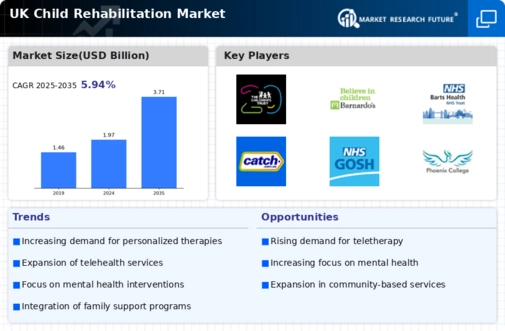Government Initiatives and Funding
Government initiatives aimed at improving child health and well-being play a significant role in shaping the child rehabilitation market. The UK government has implemented various policies and funding programs to support mental health services for children. For instance, the NHS Long Term Plan emphasizes the need for increased investment in mental health services, which includes rehabilitation programs. This commitment to funding is likely to enhance the accessibility and quality of rehabilitation services available to children. As a result, the child rehabilitation market may experience growth driven by government support, which could lead to the development of new programs and services tailored to meet the needs of children with various challenges.
Increased Awareness of Mental Health
There is a growing awareness of mental health issues among children in the UK, which is significantly influencing the child rehabilitation market. Campaigns and educational programs aimed at destigmatizing mental health have led to a greater understanding of the importance of early intervention. This heightened awareness encourages parents and educators to seek rehabilitation services for children exhibiting signs of emotional or behavioral difficulties. Consequently, the child rehabilitation market is likely to expand as more families recognize the value of professional support. The emphasis on mental health in schools and communities may also lead to increased collaboration between educational institutions and rehabilitation providers, further enhancing service delivery.
Growing Demand for Holistic Approaches
The child rehabilitation market is witnessing a shift towards holistic approaches that address the physical, emotional, and social needs of children. Parents and healthcare providers are increasingly recognizing the importance of comprehensive care that goes beyond traditional methods. This trend is reflected in the rising popularity of integrated services that combine physical therapy, psychological support, and social skills training. Such approaches are believed to yield better outcomes for children, fostering their overall development. As the demand for holistic rehabilitation services grows, the child rehabilitation market may expand to accommodate these evolving preferences. This shift could lead to the emergence of new service models that prioritize the well-being of the child in a more rounded manner.
Technological Advancements in Treatment
Technological advancements are transforming the landscape of the child rehabilitation market. Innovations such as teletherapy, virtual reality, and mobile applications are becoming increasingly integrated into rehabilitation practices. These technologies offer new avenues for delivering therapy and support, making services more accessible to children and families. For instance, teletherapy allows for remote consultations, which can be particularly beneficial for those in rural areas or with mobility challenges. As these technologies continue to evolve, they may enhance the effectiveness of rehabilitation programs, leading to improved outcomes for children. The child rehabilitation market is likely to see a surge in demand for tech-driven solutions that cater to the unique needs of young patients.
Rising Incidence of Developmental Disorders
The increasing prevalence of developmental disorders among children in the UK is a critical driver for the child rehabilitation market. Recent statistics indicate that approximately 1 in 6 children aged 5 to 16 years experience a mental health issue, which necessitates effective rehabilitation services. This growing demand for specialized care is prompting healthcare providers to enhance their offerings. As awareness of developmental disorders rises, parents and guardians are more likely to seek rehabilitation services, thereby expanding the market. The child rehabilitation market is expected to grow as more families recognize the importance of early intervention and tailored support for their children. This trend suggests a potential increase in funding and resources allocated to rehabilitation services, which could further stimulate market growth.

















Leave a Comment